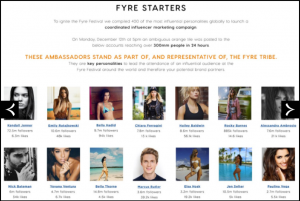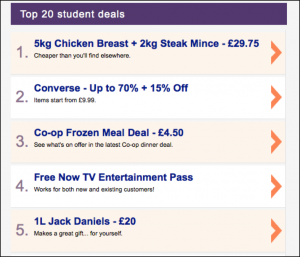Please note that these views are my own and do not represent the views of any companies discussed.
In my most recent blog post (https://blogs.brighton.ac.uk/melboscher/2017/04/10/how-to-measure-the-success-of-social-media-platforms-such-as-instagram/), I discussed how companies can measure the success of social media platforms, such as Instagram, therefore I do not discuss measures in this blog. Instead, this blog focuses on influencers and how companies are using them to promote their products on Instagram.
What is an influencer?
According to Smith (2016), there are 3.2 billion active social media users today, therefore as the use of social media continues to rise, so does the power of influencers. A social media influencer is a third party endorser who can shape an audience’s attitude through blogs, tweets and other forms of social media, hence they have become increasingly popular over recent years (Freberg et al, 2011). A 2016 study found that nearly 40% of Twitter users have made a purchase as a direct result of an influencer (Karp, 2016). Therefore, companies across all industries have looked into different ways of collaborating with influencers, as influencers can reach consumers via their blogs and social networks which brands may not be able to (Group High, 2017). When deciding which influencer to collaborate with, companies should consider the three R’s: Reach (audience size), Resonance (engagement power and audience) and Relevance (contextual fit) (Chaffey, 2015). In theory, each R should carry the same amount of weight, however it is easy for companies to immediately be attracted to influencers with the largest Reach and not consider the other two R’s, as explained below.
Follow this link to read more interesting facts and statistics about social media: https://www.brandwatch.com/blog/96-amazing-social-media-statistics-and-facts-for-2016/.
The use of influencers on Instagram: The Fitness Industry
Since its launch, Instagram has evolved from a simple photo sharing app to an efficient, profitable business platform for both individuals and businesses. Instagram represents a real mixture of people: personal trainers share their workouts, fashion bloggers share their style and travel photographers share their adventures (Shopify Blogs, 2016).
Joe Wicks, aka The Body Coach, is an online nutrition coach who has successfully influenced the lives of many people through the use of both Instagram and regular blog posts. Joe uses his Instagram page to post various workouts, recipes and progress photos of people who have had success using his 90-day diet and exercise programme, as shown in the image above (The Body Coach, 2017). The progress photos are perhaps his most efficient way of marketing, as once his followers see the success that other people have had, they will want similar results, therefore they will invest in his programme. However, Joe also publishes many of his recipes and workouts on his Instagram page, therefore those clever enough will simply follow those recipes and workouts for free, rather than investing in his programme.
The use of influencers on Instagram: The Fashion Industry
Sarah Ashcroft is a self-confessed “UK Social Influencer” and she uses her Instagram page to promote fashion items for various clothing and accessory brands. The main difference between Joe and Sarah is that Joe uses his Instagram account to promote his own brand, The Body Coach, whereas Sarah uses Instagram to promote different brands.
As you can see from the image below, Sarah informs her followers where she has purchased certain items from, and encourages them to visit the website and buy the same items. This is a common way in which many fashion brands now promote their items as both parties benefit; the influencer receives the items for free from the brand in return for promoting the item on their personal blog or other social media platforms, and the companies successfully sell the items which are being promoted. However, the relationship between an influencer and a company does not always end well.
For tips on how you too can become “Instagram famous”, give this tutorial a read: https://iphonephotographyschool.com/instagram-famous/.
When being an influencer goes wrong…
Influencers post both positive and negative opinions on brands, therefore they hold a certain degree of power over brands. However, being an influencer is not without risks. In December 2016, it was announced that a brand new festival was due to take place in the Bahamas over two weekends in April and May 2017: Fyre Festival. A massive marketing campaign employed the use of many influencers, including model Kendall Jenner. The below image was taken from the leaked Fyre Festival Pitch, which was published on the Vanity Fair website (Bolton, 2017). Interestingly, by listing the number of followers that each influencer has below their image, it signifies how the Fyre Festival organisers were primarily focused on Reach, rather than considering the other two R’s: Resonance and Relevance.
The use of influencers was initially a success for the festival, and the Fyre Starters had reached 300 million social media impressions within 48 hours (Bolton, 2017). In other words, 300 million people had been reached, signifying the power and influence that social media influencers have. As a result of the effective marketing scheme, the festival was shaped up to be a great success, however as guests started to arrive it became obvious that the event had not been properly organised, therefore the festival was cancelled. This lead to negative media attention across the world, both for the festival organisers and the influencers (Vincent, 2017). Below is an example of one of the risks of being an influencer, as although they were not in charge of organising the event, many social media users have vented their anger at the Fyre Starters for promoting such a shambolic event, therefore damaging both the festival organisers and influencers reputations.
Summary
The above examples highlight the advantages and disadvantages of both using an influencer, and being one. Additionally, they prove that the 3R’s do need to be given an equal amount of weighting when choosing an influencer. Although Fyre Festival being unsuccessful was not due to the influencers, the leaked pitch shows that they were more concerned with how to attract festival goers, rather than enlisting people who would help make the festival successful. However, perhaps the negative press this year will encourage the organisers to get their act together and create an even better event next year. One thing is for sure: the use of influencers attracts a large audience, therefore if used correctly an influencer can seriously benefit a company.
If you wish to learn more about influencer marketing on Instagram, read the following blog: https://www.shopify.co.uk/blog/115935109-the-beginners-guide-to-influencer-marketing-on-instagram.
References
Bolton, N. (2017) Exclusive: The Leaked Fyre Festival Pitch Deck is Beyond Parody. Vanity Fair. [Online] <http://www.vanityfair.com/news/2017/05/fyre-festival-pitch-deck> [Last accessed 4 May 2017]
Chaffey, D. (2015) The 10 types of online influencers [Infographic]. [Online] <http://www.smartinsights.com/online-pr/online-pr-outreach/types-of-influencers/> [Last accessed 3 May 2017]
Freberg, K., Freberg, L., Graham, K. & McGaughey, K. (2011) Who are the social media influencers? A study of public perceptions of personality. Public Relations Review. Vol. 37, Issue. 1, pp. 90-92.
Group High (2017) How to Build a Strategy Around Social Media Influencers [Online] <http://www.grouphigh.com/social-media-influencers/> [Last accessed 5 April 2017]
Instagram (2017a) Sarah Ashcroft. [Online] <https://www.instagram.com/sarahhashcroft/?hl=en> [Last accessed 4 May 2017]
Instagram (2017b) The Body Coach. [Online] <https://www.instagram.com/thebodycoach/?hl=en> [Last accessed 5 April 2017]
Karp, K. (2016) New Research: The value of influencers on Twitter [Online] <https://blog.twitter.com/2016/new-research-the-value-of-influencers-on-twitter> [Last accessed 5 April 2017]
Kaufman, G. (2017) Fyre Festival Timeline: Chronology of the Disastrous Fest. Billboard. [Online] <http://www.billboard.com/articles/columns/music-festivals/7777047/fyre-festival-timeline-fiasco> [Last accessed 4 May 2017]
Shopify Blogs (2016) The Beginner’s Guide to Influencer Marketing on Instagram. [Online] <https://www.instagram.com/about/faq/> [Last accessed 4 May 2017]
Smith, K. (2016) Marketing: 96 Amazing Social Media Statistics and Facts. Brandwatch. [Online] < https://www.brandwatch.com/blog/96-amazing-social-media-statistics-and-facts-for-2016/> [Last accessed 3 May 2017]
The Body Coach (2017) About Joe. [Online] <https://www.thebodycoach.com/about.asp>[Last accessed 4 May 2017]
Todd, C. (2017) Kendall Jenner Is At The Centre Of Another Marketing Disaster. Refinery 29. [Online] <http://www.refinery29.com/2017/04/152199/fyre-music-festival-disaster-kendall-jenner-pepsi-tweets> [Last accessed 3 May 2017]
Vincent, A. (2017) Fyre Festival: How the disaster unfolded and why the Bahamas officials have the site on lockdown. The Telegraph. 1st May 2017. [Online] <http://www.telegraph.co.uk/music/news/fyre-festival-disaster-unfolded-bahamas-officials-have-site/> [Last accessed 3 May 2017]
















